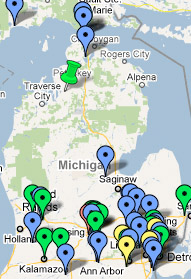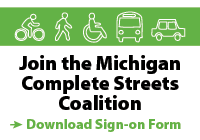You are currently browsing the tag archive for the ‘Planning’ tag.
 We’re excited to welcome Holly Madill, the new Project Coordinator for the Michigan Department of Community Health’s own Michigan Complete Streets program. This program aims to implement state and local Complete Streets policies to increase access to opportunities for physical activity in communities. MDCH is currently working with eight communities to implement Complete Streets policies.
We’re excited to welcome Holly Madill, the new Project Coordinator for the Michigan Department of Community Health’s own Michigan Complete Streets program. This program aims to implement state and local Complete Streets policies to increase access to opportunities for physical activity in communities. MDCH is currently working with eight communities to implement Complete Streets policies.
Holly holds a master’s degree in urban and regional planning and a bachelor’s degree in environmental science. Prior to coordinating the Complete Streets program, Holly provided consulting services, specializing in grant and project management, to nonprofits, private foundations, universities, and local units of government.
Good luck, Holly!
Holly Madill
Complete Streets Project Coordinator
(517) 335-8372
[email protected]
This post originally appeared on m-bike
Both Crain’s and the Detroit News are reporting on the Michigan Climate Action Plan.
According to the News:
The report by the Center for Climate Strategies said a plan devised last year for battling global warming in Michigan would help limit the state’s heat-trapping gas emissions over the next 15 years.
But more than the environment would benefit, the nonprofit group said. It projected gains of 129,000 jobs, a $25 billion uptick in the gross state product and lower prices for home energy sources such as electricity, oil and natural gas.
“This study validates our commitment to energy efficiency and renewable sources of fuel,” said Steven Chester, director of the Michigan Department of Environmental Quality. “It’s the right thing to do for a healthy environment and a healthy economy.”
So what does this report say about biking?
It actually says quite a bit as shown below — but of course it’s easy to make recommendations. Getting MDOT, SEMCOG, county road commissions, local governments, and others to adopt the implementation mechanisms to reduce green house gas emissions is the herculean task.
TLU-6. Land Use Planning and Incentives
Policy Description: Implement state policies and programs that encourage local and regional planning anddevelopment strategies in order to reduce the projected growth of VMT and corresponding GHG emissions. The state will enable each region to adopt a unique mixture of policies to reachreduction goals in its own manner. Strategies include:
- Promoting and expanding regional growth management options that result in more compact mixed-use, transit-oriented, walkable development;
- Transportation system management and pricing that allows for greater investment in alternatives to the single-occupancy vehicle, such as public transit; and
- Use of other land-use related economic development tools as recommended in the Michigan Land Use Leadership Council’s Report (2003)
Some of the implementation mechanisms include:
- Establish a process to encourage higher density housing and employment growth; mixed-use and mixed-income development; and bicycle, pedestrian, and transit-friendly development within these [priority growth] areas
- Encourage the development or rehabilitation of schools in priority growth areas to make it easier for children, teachers, and parents to get to school on foot, by bicycle, or by transit.
- Provide technical assistance to communities on best practices in zoning, parking, and street design to increase walking, bicycling, and transit use
- Develop statewide guidance and technical support for complete streets and well-connected streets to shorten trip distances, to make walking in general and walking to transit safer and more convenient, to reduce the need for overly large urban arterial roads, and to support higher density development.
TLU-7. Transit and Travel Options
Reduce the number of single-occupant vehicle trips and improve the efficiency of daily travel by
- Creating, enhancing, and promoting public transit options such as commuter rail, light rail, streetcars, and bus rapid transit;
- Enhancing transit service through route expansion, increased service frequency, longer service hours, and/or better system coordination; and
- Facilitating increased carpooling, vanpooling, biking, and walking.
These actions will reduce GHG emissions by decreasing or slowing the growth of VMT, thus reducing fuel consumption.
Some of the implementation mechanisms include:
- Ensure that these [park-and-ride] lots have bicycle storage facilities.
- Incorporate bike lanes into roadway construction and reconstruction plans wherever possible.
Proving that we haven’t forgotten about Michigan’s upper half, we here at the Michigan Complete Streets Coalition want to share some good news from the Upper Penninsula’s most populous city.
Marquette residents awoke two weeks ago to find their city a bit more walk- and bike-friendly. On October 29th, road workers completed a resurfacing project on a one-mile portion of Wright Street, which runs east to west on the city’s north end.
Aside from resurfacing, the project also included work to reconfigure Wright Street, taking it from four lanes of traffic down to two lanes and a center turn lane, with room leftover to add four-foot wide bike lanes on either side. Engineers across the country are putting roads like Wright Street on a “road diet”, finding out in the process that their streets become leaner, safer, and more efficient.
Based on their comments, city officials seem hesitant about committing to the reconfiguration as anything more than a temporary experiment. But if the Wright Street experiment is anything like other road diet projects, city officials will soon be singing the praises of fewer crashes and improved safety. In fact, the data shows that using road diets and complete streets planning principles not only makes the our streets safer and more productive, it can also help encourage increases in commercial and residential property values, and can spur new development.
Kudos to Marquette city officials for taking that kind of risk.
 The American Planning Association and the National Complete Streets Coalition have launched a research project on complete streets. The effort is intended to transform community planning, urban design, and engineering street design practices to better meet the needs of all forms of vehicular and non-vehicular transportation — cars, transit, pedestrians, (including pedestrians with disabilities), and bicyclists.
The American Planning Association and the National Complete Streets Coalition have launched a research project on complete streets. The effort is intended to transform community planning, urban design, and engineering street design practices to better meet the needs of all forms of vehicular and non-vehicular transportation — cars, transit, pedestrians, (including pedestrians with disabilities), and bicyclists.
You can learn more about this great new resource at: http://www.planning.org/research/streets/
MDOT to provide assistance in developing policies
The 2010 budget process has finally come to an end. The good news is complete streets language remain in the final transportation budget (Public Act 116 of 2009).
The complete streets section, however, was weakened into intent language, meaning that MDOT and local road agencies are encouraged but not required to develop and adopt complete streets policies. While we are disappointed that complete streets are still not yet mandatory, we are pleased to announce that language in this bill does state that “the department [MDOT] shall provide assistance to and coordinate with local road agencies and metropolitan planning organizations in developing complete street policies, including the development of model complete street policies.”
We are currently looking into who the proper contact is at MDOT to direct inquires regarding assistance with the development of complete streets policies.
Read the rest of this entry »
As reported on WSJM.com:
http://www.wsjm.com/Meeting-Welcomes-Public-To-Talk-Freight-Planning/4985082
The Southwest Michigan Planning Commission is inviting the public to its Monday [August 17, 2009] meeting next week to get public input for the Twin Cities Area Transportation Study. Associate Transportation Planner Anna Rahtz says the commission is trying to extend public out reach to get more community attendance.
The meeting will include a special presentation on freight planning. And Rahtz says other topics include the Statewide Complete Streets legislation for safe, walkable streets and the possibility of a high speed rail in Southwest Michigan. The meeting is at the Southwest Michigan Regional Airport, Monday at 9:30 a.m.
Lack of funding leads to destruction of Montcalm County roads
A YouTube video released today documents the intentional pulverization of paved roadways in Montcalm County. Faced with dwindling funds for road maintenance, many Michigan counties are being forced to replace paved roads with gravel.
While many Michigan roads are certainly in need of repair, it would be irresponsible to consider a road “fixed” until it is “complete,” meaning it accomodates all modes of transportation including pedestrians, bicyclists, transit users and those with disabilities - not just cars.
When incorporated into the original design of a roadway, Complete Streets practices often cost little extra to implement. Advocates for Complete Streets need to reframe the issue of cost into an issue of value. We must start placing value on the proper construction and maintenance of the entire right of way, not just the number of miles of paved travel lanes. This means that the many engineers, planners and politicians who have ignored the needs of the 1/3 of Americans who do not drive will have to stop treating bicyclists, pedestrians, transit users and those using mobility aides as second class citizens. Placing emphasis on value may indeed mean that communities might have to repave a few less miles of road each year and use those savings to make the roadways that they do “fix” complete.
Learn more about the costs of Complete Streets at:
http://www.completestreets.org/complete-streets-fundamentals/factsheets/costs/















